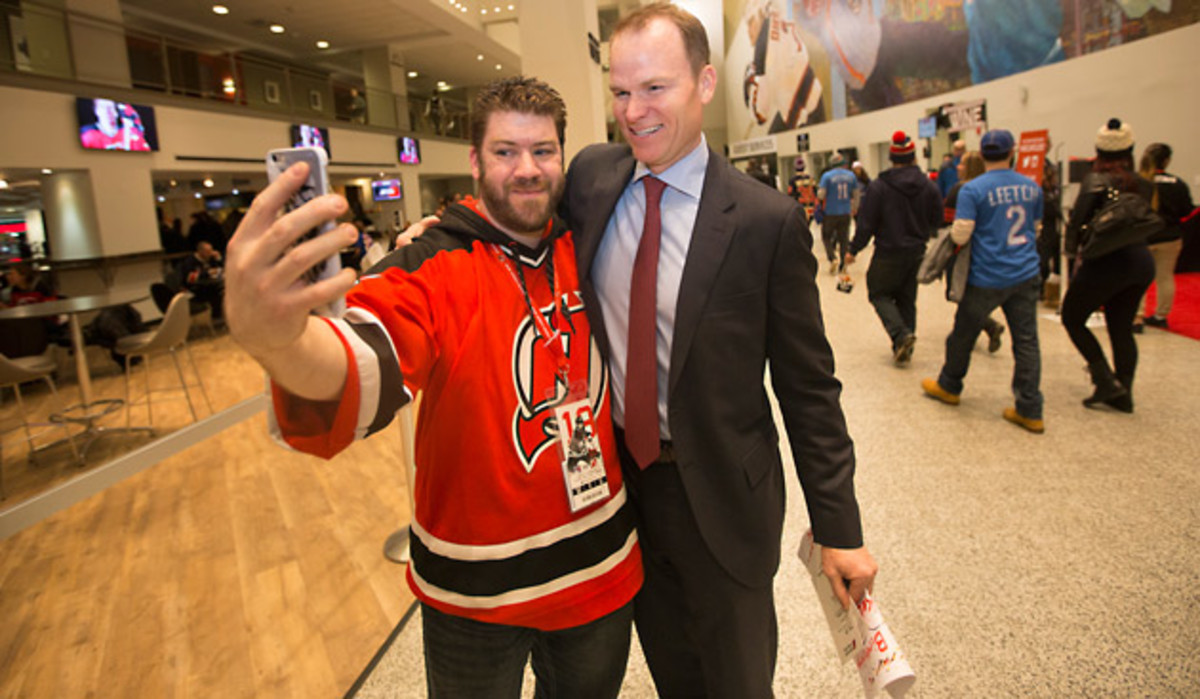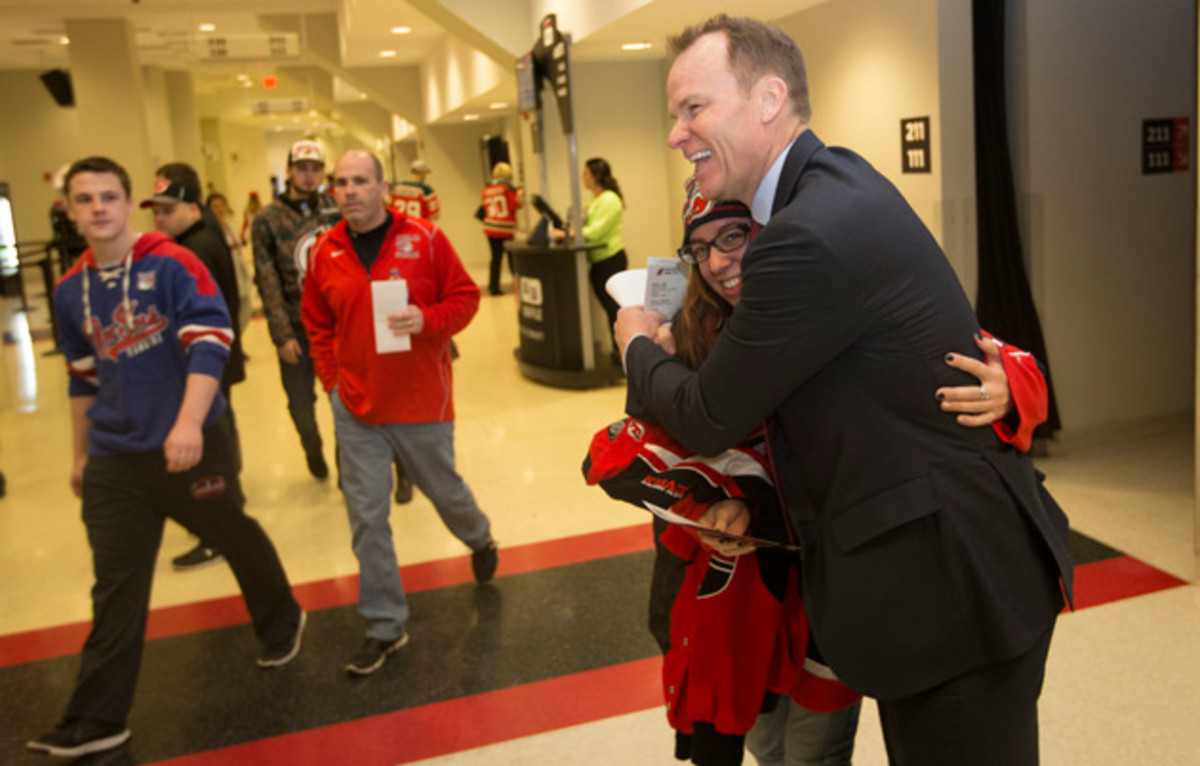Devils pitch woo in life after Lou

Get all of Jeremy Fuchs’ columns as soon as they’re published. Download the new Sports Illustrated app (iOS or Android) and personalize your experience by following your favorite teams and SI writers.
Before the Devils’ first home game of the preseason, in the Year 1 A.L. (After Lou), goaltender Cory Schneider stood waiting in the PNC Tower, the main entrance to the Prudential Center in Newark. The All-Star was not playing that night. Instead, he was departing from the Devils’ customary practices of the last quarter century: He was greeting fans.
Schneider led a group that had been gawking at the other star players, taking the fans up an escalator to the arena’s main concourse, the new face of a franchise leading a pack of followers to higher planes. Most franchises stage these types of interactions, both during the season and in the off-season. The Islanders even have healthy scratches meet with fans during regular season games at Barclays Center in Brooklyn.
NHL goalies trying to get equipment rules changes right
“For 34 years, they had a simple mantra, especially with Lou [Lamoriello],” Hugh Weber, the team's gregarious new president, later says with a staccato ha-ha-ha laugh over a Cobb Salad at the Hobby Deli, a few blocks from the Pru Center. “It’s winning as marketing. You win; the rest takes care of itself. Their outreach and philosophy was, ‘We’ll do what we can.’ Its engagement with fans in this market was pretty flat and not great. This is a business that struggled even though the team is great.”
NHL teams outside of Canada and the major U.S. markets—New York, Chicago, Los Angeles—cannot assume that fans will always come to their buildings. Teams in non-traditional markets cannot solely rely on winning. They have to make the experience of attending a game well worth it.
The Tampa Bay Lightning went to the Stanley Cup Final last year. Their rise in attendance was limited only by the capacity of their building. While the winning has helped attract fans, helping those fans to actually enjoy themselves once they entered Amalie Arena was a must.
“We spent about $85 million transforming our building,” says Steve Griggs, the CEO of the Lightning. “We’ve transformed the products and services. When team performance took off, we were ready.” This meant new scoreboards and seats, and investments in changing the concourses.
Being ready for a long playoff run takes years of planning and planting seeds for fans long before they can become paying season ticket holders. The Arizona Coyotes have focused their efforts almost exclusively on young fans—enticing them by being “drafted” by the team and setting up mobile tours across the Phoenix area during the summer. Knowing that many who live in the Phoenix area are transplants from northern cities, the Coyotes are trying to make sure that the next generation doesn't follow in their parents’ footsteps and root for their old teams.
“In order for the Arizona Coyotes to thrive,” says John Pierce, the chief marketing officer for the team, “kids in this market have to grow up [rooting] for their hometown team.”

The Devils, until now, had not participated in the standard building of a fan base. With their change in a strategy, they have started a long process of selling their new team outlook to fans with winning the Stanley Cup, as always, the goal.
Lamoriello led the Devils to legendary heights during his 28-year run as president, GM and sometime coach. The team made the postseason 21 times. It won three Stanley Cups. It established a line of Hall of Famers in Martin Brodeur, Scott Niedermayer and Scott Stevens. Lamoriello made hockey in New Jersey relevant, occasionally challenging their cross-river rivals, the New York Rangers, for fans and attention.
But the Devils were buttoned up to the extreme. They were jokingly referred to as The Firm, after the 1991 book by John Grisham about a law practice with mob ties. In Lou’s Firm, no facial hair was allowed; neatly pressed suits were a requirement. The code words were loyalty and secrecy. “We meant it in the sense that once you’re in, you can’t get out,” says former defenseman Ken Daneyko, who played parts of 20 seasons with the Devils. “You won’t leave on your own terms.”
Despite the three Cups, adding phrases such as "left-wing lock" to the hockey lexicon, and years of winning, the Devils never turned their success into consistent gate receipts. During the 2003 playoffs during which they defeated the Anaheim Ducks in seven games for the Cup, the Devils did not have a home sellout until the third round. Since 1999, the year of their second Cup, they have never finished higher than 19th in the NHL's attendance rankings.
That inability to bring fans through the doors was crushing for a franchise that Wayne Gretzky once called “Mickey Mouse" and played in a city that hockey analyst Barry Melrose called “horrible.” In 2013, the NHL was allegedly set to take over ownership of the team, which had debts of at least $200 million, according to the Bergen Record.
Two hockey outsiders saved the Firm: Josh Harris and David Blitzer, co-owners of the NBA's Philadelphia 76ers, who bought the team in ‘13 for a reported $320 million, wiping out debts and setting the slate clean.
The SI Extra Newsletter Get the best of Sports Illustrated delivered right to your inbox
Subscribe
Harris and Blitzer brought in new leadership and tripled staff in the effort to answer one question: How does a team with three Stanley Cups not have a waiting list?
“Winning doesn’t cure all,” says Daniel Cherry, the chief marketing officer who is in his first season with the team. “Winning should be an accelerant, but it can’t replace the hard yards of winning off the ice, building connections in the community. If you forget about that, you lose everything.”
For a team that has now missed the playoffs in five of the last six seasons (a surprise run to the 2012 Cup final being the last hurrah) and has only one connection to the glory days—39-year-old winger Patrik Elias, who has been injured and out for most of the season—the departure of Lou and other hockey operations staff was a breath of fresh air.
“This is no disrespect to anyone who was here before,” says defenseman and captain Andy Greene. “But change was needed.”
Through a Maple Leafs spokesman, Lamoriello declined comment.

Change started to take place in August 2013. Management's first tasks included fixing a leaking roof that had not been patched after Hurricane Sandy a year earlier. It kicked into high gear when Lamoriello unexpectedly left the organization to take over as general manager of the Toronto Maple Leafs last July. This allowed new GM Ray Shero and coach John Hynes to put their fingerprints on the Devils, creating an up-tempo style of play.
The off-ice leadership plays the same way. During each home game, Weber does a day’s worth of cardio by speed walking nearly every inch of the building. He knows the hard work of rebuilding a franchise. He was president of the NBA's New Orleans Pelicans when Hurricane Katrina hit, and was instrumental in keeping the team in that city, personally leading a “100 events in 100 days” campaign. Weber helped season-ticket holders host events in their homes to persuade others to purchase plans.
Weber’s walk starts with a leap up the steps, two at a time, to the last row of section 208 to greet four tattooed and bearded fans. A guy in the main concourse walks up, gives him a big bro hug, and says, “You’re my boy, man.” And the three girls who take a selfie with Weber. One is wearing a bright orange cast on her left arm; Weber makes sure to sign it.
The arena is Weber’s Rolodex. “It’s as if you’re hosting 12 people at your house,” he says. Except this house can hold 17,625 of his closest friends.
Jersey Boy Kyle Palmieri giving Devils his best in homecoming
There is a life-sized bobblehead of forward Mike Cammalleri in the main concourse. The arena serves “Jersey” food, including boardwalk-inspired fried dough and mojo chicken and sugar-glazed smoked ham from Newark’s Ironbound district. And yes, facial hair is allowed.
“When a visitor stops a native on the street, [and says] ‘I’m here for 48 hours, what are the five things we have to do,” Weber says, “[and] when we’re one of those five, then we’ve done it.”
Weber is fostering a fan-first culture that encourages a person to stop him at the base of an escalator and tell him that a dressing at the salad bar tasted funky. (Weber immediately went up and tried it. He said it was fine.)
The changes have even made the legends from the Firm’s glory days enthusiastic. Brodeur, who spent all but seven of his 1,266 games with Lamoriello and the Devils, said the new culture is exciting.
“It’s refreshing,” says the legendary former goalie, who is now the assistant GM of the St. Louis Blues. “I’ve known this organization and this place one way. And now it’s totally different. But it’s good to see these guys, and see these guys refreshed about playing the game. And they’re doing well.”
The team gave 35,000 tickets this season to Newark residents in honor of the city’s 350th anniversary, and is freed up 82 work hours per employee during the year to volunteer in and around the city. It’s about ingraining the team into the local culture, to make Newark residents proud of their hockey-playing neighbor.
“They want to represent that they are from this side of the river,” Weber says. “They’re not going to wear a Yankees hat. So what do you wear? [Newark-bred rapper] Fetty Wap wears Devils stuff, for that reason.”
The process of transformation is often slow. The Devils still rank 26th in attendance, and Weber acknowledged that this season is only the beginning of what could be a five-year process. But the seeds are being planted. The team has Schneider, one of the best five goalies in the league, and a rising star in Jersey-native Kyle Palmieri, who has more than doubled his previous career-high in goals (14).
The Firm was back for one night in February, when the old gang gathered to celebrate Brodeur’s number 30 being raised to the rafters. There were Stevens and Niedermayer, Lamoriello and former coach Jacques Lemaire. Lou received the second-loudest ovation after Brodeur’s—and the beginning of the goalie’s speech was drowned out by the fan noise.
But then the ceremony ended. Lou headed back to Toronto; Brodeur flew to meet the Blues in Florida, the Firm’s closing argument was finished. And then Weber did his walk-around the arena and Schneider stopped 20 shots in a 2–1 Devils win, the new normal firmly in place.
